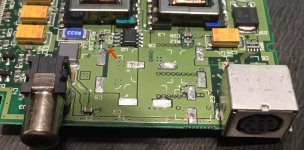OleLila
Well-known member
I had acquired a nonworking powerbook duo 280. It would chime, then make a loud, brief static sound through the speakers and go to a grey screen only. I decided to recap and see if that fixed it. While cleaning, around the negative terminal of C9, I found a broken resistor. As it was out of place and broken, I prepped its tiny pads as well. Remarkably, i do have another nonworking Duo 280 with this resistor still in place. My questions are 1) Does this have to be replaced? If it has to do with the charging of the battery or a non essential function, I would rather do no harm and leave it alone. 2) If it does have to be replaced, what is the best way for an amateur to try it? I have a heat gun but have been hesitant to put that much heat on a board I want to keep. It is really tiny so I doubt I could solder it. I have placed some very small jumper wires in the past onto similar sized pads.


